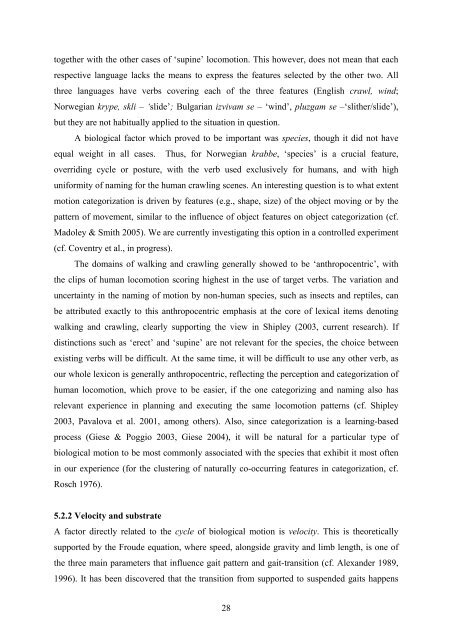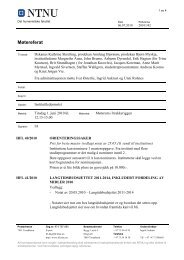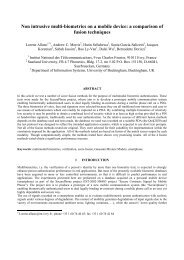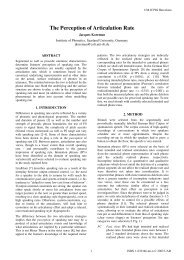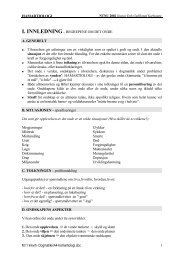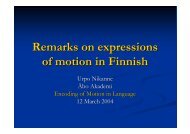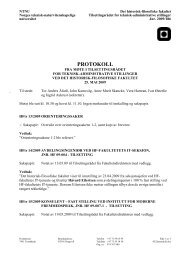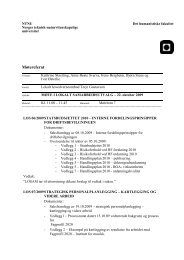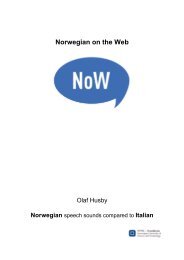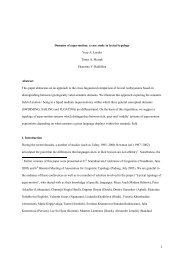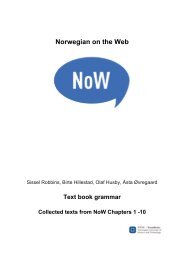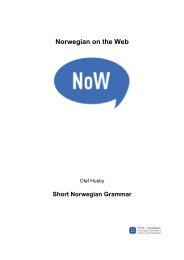In press: In: Dimitrova-Vulchanova, M - NTNU
In press: In: Dimitrova-Vulchanova, M - NTNU
In press: In: Dimitrova-Vulchanova, M - NTNU
You also want an ePaper? Increase the reach of your titles
YUMPU automatically turns print PDFs into web optimized ePapers that Google loves.
together with the other cases of ‘supine’ locomotion. This however, does not mean that each<br />
respective language lacks the means to ex<strong>press</strong> the features selected by the other two. All<br />
three languages have verbs covering each of the three features (English crawl, wind;<br />
Norwegian krype, skli – ‘slide’; Bulgarian izvivam se – ‘wind’, pluzgam se –‘slither/slide’),<br />
but they are not habitually applied to the situation in question.<br />
A biological factor which proved to be important was species, though it did not have<br />
equal weight in all cases. Thus, for Norwegian krabbe, ‘species’ is a crucial feature,<br />
overriding cycle or posture, with the verb used exclusively for humans, and with high<br />
uniformity of naming for the human crawling scenes. An interesting question is to what extent<br />
motion categorization is driven by features (e.g., shape, size) of the object moving or by the<br />
pattern of movement, similar to the influence of object features on object categorization (cf.<br />
Madoley & Smith 2005). We are currently investigating this option in a controlled experiment<br />
(cf. Coventry et al., in progress).<br />
The domains of walking and crawling generally showed to be ‘anthropocentric’, with<br />
the clips of human locomotion scoring highest in the use of target verbs. The variation and<br />
uncertainty in the naming of motion by non-human species, such as insects and reptiles, can<br />
be attributed exactly to this anthropocentric emphasis at the core of lexical items denoting<br />
walking and crawling, clearly supporting the view in Shipley (2003, current research). If<br />
distinctions such as ‘erect’ and ‘supine’ are not relevant for the species, the choice between<br />
existing verbs will be difficult. At the same time, it will be difficult to use any other verb, as<br />
our whole lexicon is generally anthropocentric, reflecting the perception and categorization of<br />
human locomotion, which prove to be easier, if the one categorizing and naming also has<br />
relevant experience in planning and executing the same locomotion patterns (cf. Shipley<br />
2003, Pavalova et al. 2001, among others). Also, since categorization is a learning-based<br />
process (Giese & Poggio 2003, Giese 2004), it will be natural for a particular type of<br />
biological motion to be most commonly associated with the species that exhibit it most often<br />
in our experience (for the clustering of naturally co-occurring features in categorization, cf.<br />
Rosch 1976).<br />
5.2.2 Velocity and substrate<br />
A factor directly related to the cycle of biological motion is velocity. This is theoretically<br />
supported by the Froude equation, where speed, alongside gravity and limb length, is one of<br />
the three main parameters that influence gait pattern and gait-transition (cf. Alexander 1989,<br />
1996). It has been discovered that the transition from supported to suspended gaits happens<br />
28


